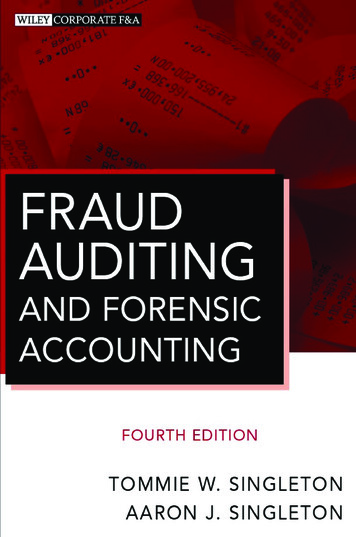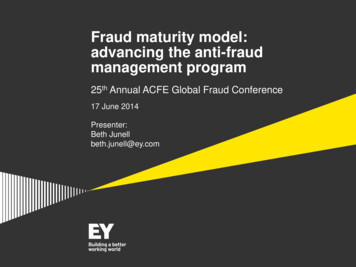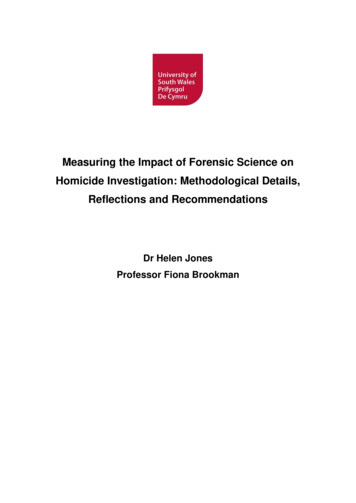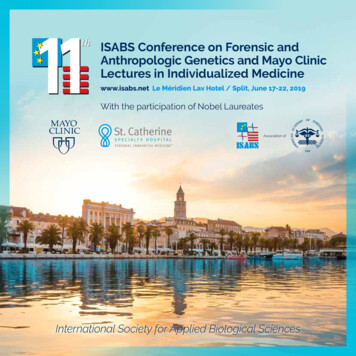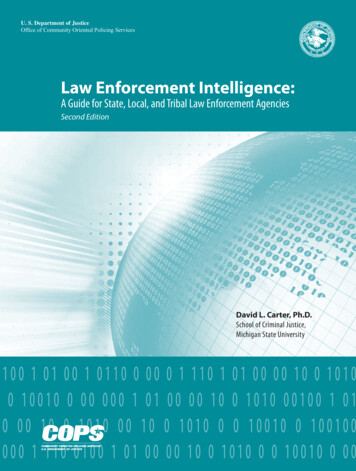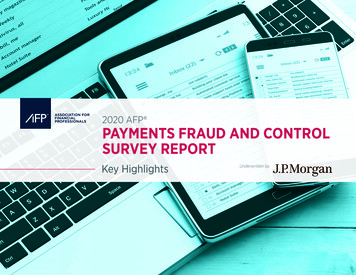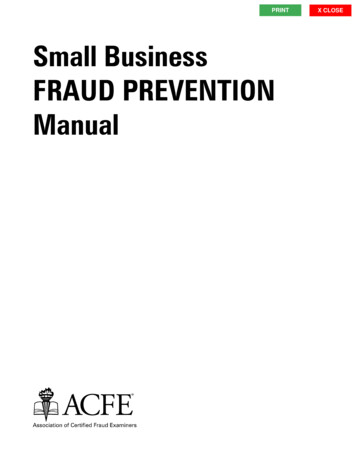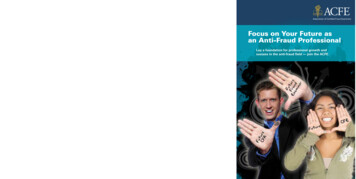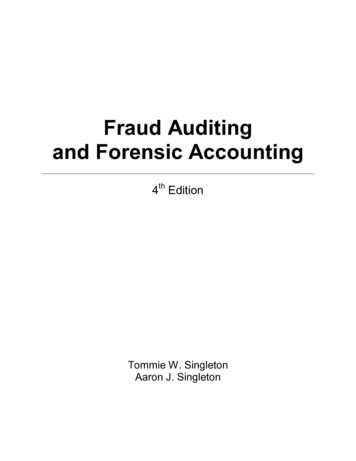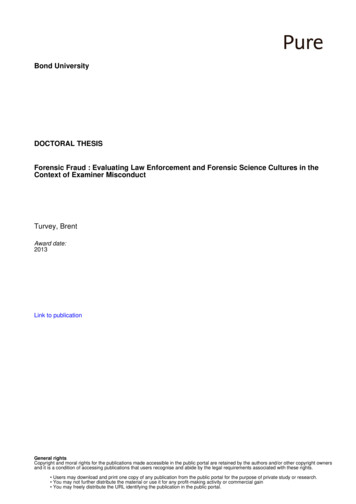
Transcription
Bond UniversityDOCTORAL THESISForensic Fraud : Evaluating Law Enforcement and Forensic Science Cultures in theContext of Examiner MisconductTurvey, BrentAward date:2013Link to publicationGeneral rightsCopyright and moral rights for the publications made accessible in the public portal are retained by the authors and/or other copyright ownersand it is a condition of accessing publications that users recognise and abide by the legal requirements associated with these rights. Users may download and print one copy of any publication from the public portal for the purpose of private study or research. You may not further distribute the material or use it for any profit-making activity or commercial gain You may freely distribute the URL identifying the publication in the public portal.
Forensic Fraud:Evaluating law enforcement and forensic sciencecultures in the context of examiner misconductPresented byBrent E. Turvey, MSStudent ID: 13057167Submitted in total fulfillment of the requirements of the degree ofDoctor of PhilosophySeptember 2012Criminology DepartmentFaculty of Humanities and Social SciencesBond UniversityQueensland, Australia
AbstractForensic fraud occurs when forensic examiners provide sworn testimony, opinions, ordocuments (e.g., reports and professional resumes) bound for court that contain deceptiveor misleading findings, opinions, or conclusions, deliberately offered in order to secure anunfair or unlawful gain. Such misconduct has an undeniably devastating impact: itdestroys the reputations of the forensic examiners involved, if not their careers; it erodespublic confidence in the institutions where they are employed; it can result in overturnedconvictions, individual and institutional liability, and costly civil judgments; and it iscorrosive to the collective faith in the justice system as a whole. However, owing to alack of research into the phenomenon of forensic fraud that is exacerbated by theconstraints on would-be whistleblowers, in tandem with the denials of forensic sciencestakeholders, there is a general perception that forensic fraud is primarily the result of afew “bad apples” rather than being cultural or systemic in origin. This dissertationexamines the problem of forensic fraud both theoretically and empirically, to assess therelationships between examiner, workplace, evidentiary, and impact variables.The present research shows that the majority of forensic examiners work for lawenforcement or government agencies, and almost exclusively for the police andprosecution. Law enforcement culture is often defined by traits that afford themotivations and rationalizations for a deviant internal subculture, actively cultivatingfraud within its ranks. It also furnishes otherwise lawful members with the skills,incentives, motivations and rationalizations for ignoring, protecting, and even publiclydefending their unlawful co-workers. Research suggests that employment circumstancesand cultural features, in conformity with Differential Association Theory, Social LearningTheory, and Role Strain, increase the likelihood that those aligned with law enforcementwill commit, tolerate, conceal, or defend acts of overt fraud.ii
The present research also shows that scientific integrity requires honesty, use of thescientific method, skepticism, objectivity, transparency, and a host of other wellestablished scientific norms. It prohibits fabrication (aka forging or dry-labbing);falsification (aka cooking); suppression of unfavorable results (aka cherry-picking);plagiarism; ghost authorship (aka honorary or gift authorship); falsification of scientificcredentials; and the reckless disregard for practice standards that ensure scientificintegrity. In this context, scientific misconduct (aka fraud) is primarily understood to bethe result of institutional failures to uphold scientific values and nurture scientific culture;these are an institution’s responsibility to detect, investigate, and correct. Morespecifically, corrupt individuals cannot be hired, or retained, by any employer withoutsome level of institutional negligence, apathy, tolerance, or even encouragement. It istherefore misleading to blame forensic fraud solely on the actions of isolated examiners.Moreover, as made clearer through the lenses of Differential Association Theory, SocialLearning Theory, and Role Strain, the mandates of scientific integrity are incompatiblewith law enforcement values and cultural pressures. Consequently, the employment oralignment of forensic examiners with law enforcement is inappropriate and fraught withunnecessary peril.In order to establish and evaluate the contextual variables that influence forensic fraud,this dissertation sought to examine and correlate the traits of fraudulent forensicexaminers (n 100); the nature of their fraud; their places of employment; and the impactof their misconduct. It was limited in scope to those cases involving fraud related to theexamination of physical evidence, and revealed in the United States from 2000 to 2010.Final data were initially assessed with a series of correlation matrices, and then examinedmore closely using multiple hierarchical regression analysis. Findings support theassertion that forensic fraud tends to be the result of cultural, pathological and systemiccauses rather than the narrow motives of single individuals. Additionally, they support theassertion that those working on behalf of the state (the police and the prosecution) areresponsible for a substantial amount, if not the majority, of publicly known cases ofiii
forensic fraud. Based on statistically significant findings, specific potentially causalfactors are identified and discussed. Subsequently, fraud management strategiessuggested by these findings are proposed.iv
Statement of OriginalityThis thesis is submitted to Bond University in fulfillment of the requirements of the degree ofDoctor of Philosophy. This thesis represents my own original work towards this researchdegree and contains no material which has been previously submitted for a degree or diplomaat this University or any other institution, except where due acknowledgement is made.Brent E. Turveyv
AcknowledgmentsThis research would not have been possible without the support and encouragement of thosein the Faculty of Humanities at Bond University. This includes those permissions given, thoseassurances afforded, and the helpful criticisms that kept everything on track throughout theprocess. On that note, I would like to thank Professor Raoul Mortley for his unwaveringsupport and confidence from start to finish. However, the greatest debt is owed to ProfessorPaul Wilson, my primary supervisor. He provided equally invaluable measures of genuineenthusiasm tempered by solid scientific edits without letting me stray from the actual tasksbefore me – as is my custom. This could not have been easy. There is no question that hisexperience, guidance, and commitment to the completion of this research made the end resultbetter on all fronts.I would also like to thank my friends and colleagues in both law enforcement and the forensicsciences for their insights, counsel, and feedback as I progressed through the sometimeswrenching stages of examination and discovery demanded by this project’s difficult subjectmatter: W. “Jerry” Chisum (Criminalist, California Department of Justice, ret.); Craig Cooley,JD (formerly of the Innocence Project at the Cardozo Law School in New York); CaptainThomas “Duke” DeLaHunt (Crowley Maritime, ret.); Ofc. Joe Delery (Forensic Examiner,New Orleans Police Department); Ronald Miller, MS (Forensic Investigator, Vancouver,WA); Det. Rick Ragsdale (Stockton Police Department, ret.); Det. John Savino (New YorkCity Police Department, ret.); and Dr. John Thornton (Criminalist, University of California –Davis). Without these individuals acting as sounding boards and confidantes, the findings inthis thesis and their informed discussion would have suffered tremendously.It is also necessary to acknowledge the invaluable tutelage and assistance of my friend andcolleague Dr. Shawn Mikulay. He taught me the value of hierarchical regression analysis,how to run said regressions, and how to faithfully interpret them with scientific caution. Thiswas no small task, and without his assistance this part of the research would have fallen flat.Finally, I would like to thank my family for their support and encouragement throughout mycandidature. They put up with a lot given my generally intense caseload and other writingprojects – and this added that much more to the burden. Mostly, however, I am grateful to mywife Melissa – for listening, advising, and generally helping me to get there when I wasn’t.vi
DedicationThis research effort is dedicated to Thomas “Duke” DeLaHunt (1924-2012) – a Captain ofshipping vessels from Alaska to the Orient, a trusted mentor, and a friend. His vast experienceand counsel regarding the politics of criminality and corruption within law enforcementduring the writing of this dissertation were essential. His voice is missed.vii
Table of ContentsChapter 1 – Introduction1 – 16Chapter 2 – Occupational Fraud17 – 44Chapter 3 – Forensic Science: A Primer45 – 56Chapter 4 – Fraud and Law Enforcement Culture57 – 80Chapter 5 – Fraud and Scientific Culture81 – 119Chapter 6 – Contrasting Scientific Integrity withLaw Enforcement Culture120 – 143Chapter 7 – Forensic Fraud: A Literature Review144 – 170Chapter 8 – Data, Parameters, and Frequency Results171 – 196Chapter 9 – Multivariate Analysis: Results and Discussion197 – 225Chapter 10 – Conclusions226 – 257References258 – 307viii
Figures, Charts, and TablesFigure 2-1: ACFE Occupational Fraud andAbuse Classification System27Figure 2-2: Cressey’s Fraud Triangle34Table 6.1: Law Enforcement Culture v. Scientific Integrity140Chart 8.1: Examiner Science Education185Chart 8.2: Examiner Job Description187Chart 8.3: Examiner History188Chart 8.4: Examiner Approach to Fraud190Chart 8.5: Employers191Chart 8.6: Frequency of Fraud by Evidence Type193Chart 8.7: Examiner Consequences194Table 9.1: Employer and Examiner Variables Correlatedwith Approach to Fraud199Table 9.2: Employer and Examiner Variables Correlatedwith Evidence Type200Table 9.3: Employer and Examiner Variables Correlatedwith Impact201Table 9.4: Hierarchical multiple regressions of Employer,Job Description and Examiner Variables onApproaches to Fraud204ix
Table 9.5: Hierarchical multiple regressions of Employer,Job Description and Examiner Variables onImpact of Fraud211Table 9.6: Hierarchical multiple regressions of Employer,Job Description and Examiner Variables onEvidence Affected216x
Chapter 1Introduction“Where a proffered expert knows himself or herself to be a quack or otherwise tobe offering false testimony, the situation is like that of any other witness who isperpetrating a fraud on the court. Such acts are illegal as well as unethical.”Michael J. Saks (2001)Professor of Law & PsychologySandra Day O’Connor College of LawThis dissertation examines and correlates the traits of fraudulent forensic examiners; theirfraud related activity; and their places of employment. To ensure timeliness and providefor comparability, it is limited in scope to those cases revealed in the United States from2000 to 2010. It is a study that seeks to inform and add to our theoretical understandingof a specific yet potent strain of employee fraud in the criminal justice system. Based onthe findings of this study, potential causal factors are identified and discussed.Subsequently, relevant fraud management strategies are proposed.BackgroundThe events that have accumulated over the course of this researcher’s career to confirmthe need for this study, and provide sufficient motivation for its completion, are numerousand ongoing. The earliest took place immediately after to the completion of thisresearcher’s graduate studies in forensic science in 1995: a research paper that had beenprovided on-line was taken in its entirety and presented elsewhere under the name ofanother. Upon discovery and further investigation, it was learned that the personresponsible, a forensic psychologist, was no stranger to fraud. Then the Chair of theForensic Science program at National University in San Diego, California, it was learnedthat the plagiarist had purloined the research of others in at least one Canadian journal.He had also been accused of misrepresenting the nature of his relationship with the1
Orange County Coroner’s Office by means of printing up misleading business cards.Further still, his professional resume was full of incomplete and misleading informationand affiliations. Ultimately, and subsequent to a complaint filed by this researcher, thisindividual was forced to resign his membership with the American Academy of ForensicSciences, and contemporaneously ceased to be the Chair of the Forensic Science programat National University. That someone would do these things so openly, let alone aprofessional of apparent high standing in the forensic science community, and thatnobody had complained about it in writing save a recently graduated student of forensicscience, left an impression.Over the past 17 years of forensic practice, this researcher has observed or learned ofcountless instances of unrepentant forensic fraud by practitioners from all over the UnitedStates, and around the world. A severe outcome, with proven fraudsters stripped of theiremployment, penalized by their respective professional organizations, and criminallycharged is not at all typical. Often fraud is minimized, ignored, or in extreme casessimply denied by those in the forensic science community. For example, Budowle (2007),speaking for the FBI crime laboratory, insists that “most people do good jobs”, thatforensic fraud is not a significant issue, and that any problems are “most often humanerror”; Collins and Jarvis (2007), speaking for an organization formed by those associatedwith the American Society of Crime Lab Directors Laboratory Accreditation Board(ASCLD-LAB), similarly assert that “Forensic scientists are human beings. As such theywill sometimes make mistakes and, in some very rare instances, push the boundaries ofethical behavior.”; and, in response to multiple and ongoing scandals involving examinerfraud since 2005 at the U.S. Army Criminal Investigation Laboratory (USACIL), theArmy's Criminal Investigation Command, which oversees the lab, has conceded only that"As with all crime labs across the county, human error does occur from time totime" (Taylor and Doyle, 2011) – in essence ignoring the issue of fraud altogether1. Manyleaders in the forensic science community, it seems, are content to explain fraudulent1For further discussion, see Chapters 6 & 7 with respect to Bad Apple Theory.2
examiners away, or deny their existence, despite continuous and sometimesoverwhelming evidence of the problem. This sets the tone for the attitudes and argumentsthat must necessarily follow from their subordinates, as will be discussed in laterchapters.Different from that of many forensic science stakeholders, this researcher’s perspectivehas been enhanced by at least the following major events in the forensic sciencecommunity over the past ten years:1. The ongoing and in some cases repeated instances of major crime lab scandal, toinclude multiple instances of fraud and error, over the past 15 years (see generaldiscussions in Cooley, 2004, 2007a, and 2007b; DiFonzo, 2005; DiFonzo andStern, 2007; Giannelli, 2010; and Thompson, 2008)2.2. The publication of the National Academy of Science Report on forensic science(aka The NAS report; Edwards and Gotsonis, 2009). The NAS Report was acongressionally funded system-wide investigation and review of the forensicscience disciplines and related forensic laboratory practice. It was initiated by theUnited States Congress due to the publication of an ongoing series of critical legalreviews regarding the evident bias and lack of science in forensic practice; theongoing occurrence of highly publicized forensic frauds, blunders, and forensiclaboratory scandals across the United States; and the ever-increasing number ofDNA exonerations sourced back to flawed or misleading forensic evidencedocumented by groups such as the Innocence Project (see http://www.innocenceproject.org; see also Garrett, 2008 and Garrett and Neufeld, 2009).The NAS Report confirmed the lack of scientific foundation for the majority offorensic science methods, and an inappropriate alignment between forensic2Numerous specific crime lab scandals are adduced throughout this dissertation as necessary.3
scientists and their law enforcement employers. It also recognized the lack ofempirical research into the nature and causes of forensic fraud and error.3. The publication of Preventable Error: A Report on Prosecutorial Misconduct inCalifornia 1997-2009 by the Northern California Innocence Project (Ridolphi andPossley, 2010). This landmark study of the largest criminal justice system in theUnited States (California) found prosecutorial misconduct more common thanpreviously thought, including that related to suppressing or misrepresentingphysical evidence. It also found that when harmful misconduct does occur (p.3)“those empowered to address the problem—California state and federal courts,prosecutors and the California State Bar—repeatedly fail to take meaningfulaction. Courts fail to report prosecutorial misconduct (despite having a statutoryobligation to do so), prosecutors deny that it occurred, and the California StateBar almost never disciplines it.” This is clearly related to, and not surprisinglysimilar to, the problems faced in the forensic science community regardingforensic fraud.These experiences and events, expanded by myriad professional encounters withfraudulent examiners as part of regular casework, have provided a durable source ofmotivation for the current research effort.Definitions of Key TermsTo contextualize this dissertation, and facilitate continuity between this and any future orrelated projects, it is necessary to operationalize at least the following key terms inadvance: scientific misconduct, forensic examiner/ forensic practitioner, forensic fraud,and perjury. Other pertinent terms will be defined as needed.Scientific Misconduct4
According to the guidelines adopted by the United States Office of Research Integrity,scientific misconduct is defined by acts that include the fabrication of data, thefalsification of results, and plagiarism. However, it has also been argued to include ghostauthorship and the falsification of credentials (Krimsky, 2007). While the wrongfulnessof falsifying scientific credentials and fabricating data are fairly straightforward, the longstanding practice of ghost authorship in the scientific community requires someexplanation. As explained in Krimsky (2007; pp.450): “Ghost authorship occurs when theperson whose name appears on the publication was not involved either in doing theresearch, framing the ideas behind the article, or in writing the article. Alternatively, itcan occur when an individual who has made substantial contributions to the manuscript isnot named as an author or whose contributions are not cited in the acknowledgments.”This practice is also referred to by some as “gift authorship” (Jones, 2003; p.245).Essentially, it involves hiding who did the work by giving credit that has not actuallybeen earned.Forensic ExaminersThe terms forensic examiner and forensic practitioner will generally refer to anyprofessional who examines and interprets facts, evidence, or data with the expectation ofcourtroom testimony. As explained in Turvey (2011; p.xxii):Criminal investigators are tasked with serving the criminal justice system by establishing theobjective facts and evidence of a given case. Forensic examiners are tasked with analyzing theevidence and interpreting the facts objectively.Forensic examiners are defined by the fact that they anticipate courtroom testimony. Asexplained in Thornton and Peterson (2007; p3):The single feature that distinguishes forensic scientists from any other scientist is the certainexpectation that they will appear in court and testify to their findings and offer an opinion as to thesignificance of those findings. The forensic scientist will testify not only to what things are, but towhat things mean.5
This provides that a forensic scientist does not just test or examine evidence and thenrecord the results; they are meant to explore, understand, and explain its significance to aan attorney, judge or jury. The defining quality of a forensic examiner is the possibilitythat they will be called upon to present their findings, under penalty of perjury, in a courtof law. Subsequently, they will be asked to explain to the court what those findings meanand how they came to them. This can be as straightforward as recording informationabout drug identifications, weights, and cash amounts; or it can be as complex asreconstructing a crime scene and determining cause and manner of death.Forensic examiners are therefore found across a broad spectrum of professions. Thiswould include criminalists and other forensic scientists such as forensic pathologists,forensic toxicologists, firearm and tool mark examiners, forensic odontologists, crimereconstructionists, criminal profilers, forensic criminologists, forensic psychologists andeven forensic victimologists. It would also include an array of law enforcement officersprocessing evidence or testifying as experts in a variety of specialty areas, such as gangculture, sexual assault, drug dealer profiles, drug lab profiles, and case linkage analysis.The scope of the present research is limited, however, to forensic examiners that workdirectly with physical evidence.Forensic FraudForensic fraud occurs when forensic examiners provide sworn testimony, opinions, ordocuments (e.g., reports and professional resumes) bound for court that contain deceptiveor misleading findings, opinions, or conclusions, deliberately offered in order to secure anunfair or unlawful gain. As defined in the present research, forensic fraud is necessarilythat which is committed by a forensic examiner. It is distinct from deceptive ormisleading acts that may be committed by others, such as fact witnesses, patrol officers,attorneys, and judges.6
Forensic fraud, while certainly a form of scientific misconduct, does not necessarilyinvolve perjury. Perjury is criminal charge. It is the act of lying or making verifiably falsestatements on a material matter under oath or affirmation in a court of law or in anysworn statements in writing (Black, 1990). A violation of specific criminal statutes, it isnot sufficient for a statement to be false to meet the threshold of perjury; it must be anintentionally false statement regarding a material fact—a fact relevant to the case at hand.As further explained in Turvey (2008; p. 734):The act of lying or making verifiably false statements on a material matter under oath oraffirmation in a court of law or in any sworn statements in writing. A criminal act, it is notsufficient that the statement be false to be considered perjury; it must be regarding a material fact—a fact that is relevant to the situation. Consequently, not all lies under oath are consideredperjury.For example, in Title 18 of the U.S. Code of Laws, §1621 “General Perjury” provides thatperjury involves a person “having taken an oath before a competent tribunal, officer, orperson, in any case in which a law of the United States authorizes an oath to beadministered, that he will testify, declare, depose, or certify truly, or that any writtentestimony, declaration, deposition, or certificate by him subscribed, is true, willfully andcontrary to such oath states or subscribes any material matter which he does not believeto be true.”As it stands, not all intentionally false statements made under oath by a forensic examinerare considered perjury – nor are all forensic examiners who give false testimony underoath charged with a crime. The decision to bring such charges is made at the discretion ofthe District Attorney’s Office in the jurisdiction where the false testimony occurred.Joseph Serowik, CriminalistCleveland Police Department Crime Laboratory7
In 1988, Michael Green was convicted of rape, however he was later exonerated byDNA evidence and released in 2001. As reported in Gillispie (2004; p.A1):Edward Blake, a pioneer in the use of DNA for criminal investigations who was hired by Green'sattorneys, concluded that Serowik "intentionally fabricated false evidence against Green, testifiedat Mr. Green's trial with a reckless disregard for the truth, and committed scientific fraud."Blake wrote that Serowik turned a washcloth into incriminating evidence against Green by makingassumptions that had no scientific basis. Serowik told jurors that the man who used the washclothto wipe himself after raping a cancer patient in May 1988 at the Cleveland Clinic Hotel had thesame blood type as Green's. Serowik also testified that the semen on the washcloth could havebeen left by only 16 percent of the male population. Without his faulty assumptions, Blake wrote,Serowik should have concluded that no man could have been excluded as a possible source of thesemen on the washcloth, rendering it meaningless in the Green prosecution.Serowik also testified that a hair found on the washcloth shared similarities with hair taken fromGreen's head, and went on to say that the likelihood they came from two different people wasabout 1 in 40,000. But another expert hired by Green's attorneys said Serowik should not havemade that assertion because hair analyses aren't precise enough to calculate probabilities.In addition, Serowik admitted that he had no idea what part of the body the hair came from,making any comparisons scientifically improper. Determining the part of the body a hair comesfrom is not only essential, it's easy to do, wrote Max M. Houck, director of the Forensic ScienceInitiative and a professor at West Virginia University. With proper training, he wrote, it's about asdifficult as distinguishing a Volkswagen from a Cadillac. The fact that Serowik apparently couldn'tdo it, together with his misuse and misstatement of statistics, led Houck to conclude that "JosephSerowik demonstrates a fundamental lack of knowledge about conducting forensic hairexaminations.”“Mr. Serowik was allowed to conduct hair examinations without proper education, training,supervision, or protocols," Houck wrote. "He conducted these examinations in numerous cases,repeatedly made the same mistakes, and did not seek any training by qualified experts in forensichair examinations."Houck and Blake pointed out that Serowik was supervised by someone who knew even less aboutthe scientific disciplines involved than he did. And yet it was [Victor] Kovacic, the lab supervisor,who oversaw and signed off on the hair analysis in the Green case. A retired police officer who hasheaded the Cleveland crime lab since 1985, Kovacic acknowledged in February that he had no8
expertise in either hair analysis or serology (the study of bodily fluids) and that his technicianscould have made up their findings and he wouldn't have known the difference. It was a "grossdeviation from accepted practice" to have an inexperienced serologist supervised by someone withno experience or training in the field, Blake wrote in his report.Ultimately, Mr. Green sued the City of Cleveland and won a settlement that included1.6 million dollars and a mandatory forensic audit of the casework of both Mr.Serowik and the Cleveland Police Crime Laboratory (a random sample); this resultedin the review of approximately 100 cases (Green v. City of Cleveland, et al, 2004).During his sworn deposition for that action, Mr. Serowik agreed that his assumptionsabout the evidence in the Green case, and his subsequent expert testimony, were“inappropriate” (Gillispie, 2004). Despite acknowledging his false testimony, Mr.Serowik was not charged with perjury.Initially, the Cleveland Police Crime Laboratory retained Mr. Serowik as anemployee, but removed him from forensic casework. However, later in 2004, he wasplaced on leave and then ultimately terminated (Milicia, 2007). Mr. Serowik was notcharged with any crimes related to his false testimony.As a result of the mandatory audit of Mr. Serowik’s casework and testimony, twoother convictions were questioned by the Innocence Project, which reported that(Salzberg, 2007):New DNA tests show that two men's convictions for a 1997 murder were based on fraudulenttestimony from a City of Cleveland forensic analyst - whose false testimony also wrongfullyconvicted another man who was exonerated in 2001 and led to an audit of cases covering a 16-yearperiod that revealed serious problems in at least a half-dozen convictions - the Innocence Projectsaid today. In legal papers filed today, the Innocence Project and the Ohio Innocence Project askedstate courts to vacate the convictions of Thomas Siller and Walter Zimmer.In 2009, because of Mr. Serowik’s testimony, Mr. Siller’s conviction was vacatedand he was ordered to receive a new trial (Puente, 2009).9
This case involved fraud by a law enforcement employed forensic examiner relatedto both physical evidence and expert credentials. According to the record, Mr.Serowik gave intentionally false and misleading testimony about his findings, whatthey meant, the current state of the forensic science literature, and his expertise. Assuch, his acts of fraud having been uncovered during the parameters set for this study(2000-2010), data from Mr. Serowik was included in the final data set. See Chapter8: Data, Parameters, and Frequency Results for details regarding specific inclusioncriteria and data collected.RationaleForensic fraud exists as a sore and often forbidden
prosecution. Law enforcement culture is often defined by traits that afford the motivations and rationalizations for a deviant internal subculture, actively cultivating fraud within its ranks. It also furnishes otherwise lawful members with the skills, incentives, motivations and rationalizations for ignoring, protecting, and even publicly
